Adriano Falcioni - Guilmant: Complete Organ Sonatas (2015)

Artist: Adriano Falcioni
Title: Guilmant: Complete Organ Sonatas
Year Of Release: 2015
Label: Brilliant Classics
Genre: Classical
Quality: FLAC (image + .cue, log, scans)
Total Time: 03:05:19
Total Size: 706 MB
WebSite: Album Preview
Tracklist:Title: Guilmant: Complete Organ Sonatas
Year Of Release: 2015
Label: Brilliant Classics
Genre: Classical
Quality: FLAC (image + .cue, log, scans)
Total Time: 03:05:19
Total Size: 706 MB
WebSite: Album Preview
Felix Alexandre Guilmant (1837-1911)
Complete Organ Sonatas
CD 1
01 - 03. Sonata No.1 in D minor, Op.42
04 - 06. Sonata No.2 in D major, Op.50
07 - 09. Sonata No.3 in C minor, Op.56
CD 2
01 - 04. Sonata No.4 in D minor, Op.61
05 - 09. Sonata No.5 in C minor, Op.80
10 - 12. Sonata No.6 in B minor, Op.86
CD 3
01 - 06. Sonata No.7 in F major, Op.89
07 - 11. Sonata No.8 in A major, Op.91
Adriano Falcionis recordings on Brilliant Classics of a diverse repertoire, from Couperin to Bruhns to Franck, reveal an uncommonly versatile artist, and one who relishes the colouristic possibilities of each particular instrument at hand: he has recorded the complete sonatas of Alexandre Guilmant on a richly caparisoned, eminently suitable four-manual organ from 1897 by Carlo Vegezzi-Bossi, who was one of the foremost Italian builders around the turn of the last century. Only one other recording of the complete sonatas is available, retailing at full price, making this new recording an essential acquisition for organ buffs as well as any enthusiast for post-Wagnerian instrumental palettes. Formally speaking, the sonatas owe their structure to the Classical models of early German Romanticism such as Mendelssohn, whose sonatas have likewise enjoyed far greater familiarity than they do now, and Guilmants background he was born into a family of organ builders and organists at Boulogne-sur-Mer in 1837 gave him an intimate familiarity with the contrapuntal masters of the Baroque such as Bach and Handel. Appointed organist at La Trinite church in Paris in 1871 (where, half a century later, the post of titulaire would be occupied by one Olivier Messiaen), he succeeded Widor as professor of organ at the Paris Conservatoire, at the same time beginning a career as a virtuoso organist that took him on concert tours of Europe and America. Thus the organ sonatas do not waft on clouds of Franckian incense, but are more rhythmically muscular, with outer movements often powered with a toccata-like drive that distinguishes the finale of his first sonata, perhaps his single best-known movement these days. Falcioni reveals the subsequent seven works to be no less worthy of investigation.




![Tomasz Stanko, Polskie Radio - Jazz Rock Company: Live at Akwarium (Polish Radio Sessions vol. 6/6) (2025) [Hi-Res] Tomasz Stanko, Polskie Radio - Jazz Rock Company: Live at Akwarium (Polish Radio Sessions vol. 6/6) (2025) [Hi-Res]](https://www.dibpic.com/uploads/posts/2025-12/1765796554_cover.jpg)
![Rachel Kitchlew, SFJ - Flirty Ghost (2025) [Hi-Res] Rachel Kitchlew, SFJ - Flirty Ghost (2025) [Hi-Res]](https://www.dibpic.com/uploads/posts/2025-12/1765896408_qvf41hr1ljj8a_600.jpg)

![Tomasz Stańko, Tomasz Szukalski, Dave Holland & Edward Vesala - Balladyna (1976/2025) [Hi-Res] Tomasz Stańko, Tomasz Szukalski, Dave Holland & Edward Vesala - Balladyna (1976/2025) [Hi-Res]](https://www.dibpic.com/uploads/posts/2025-12/1765717548_cover.jpg)
